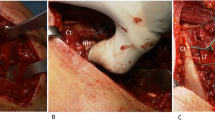Abstract
Introduction
Fractures of the proximal humerus are very common, but controversy still exists about the preferred type of operative treatment in displaced fractures.
Materials and methods
We followed 15 patients (12 female and 3 male, average age 70 years) with 15 dislocated type II (9) and III (6) proximal humeral fractures after helix wire osteosynthesis.
Results
A nonunion developed in seven cases (47%). Three patients were reoperated (prosthesis: 2, repair: 1). Seven patients were available for follow-up (average: 14 months). Three patients had a Constant score of 80 or more and four patients had a score under 70 points.
Conclusion
The results of the helix wire osteosynthesis for proximal humeral fractures are poor and we do not recommend its further use.

Similar content being viewed by others
References
Adedapo A, Ikpeme JO (2001) The results of internal fixation of three- and four-part proximal humeral fractures with the polarus nail. Injury 32:115–121
Baron JA, Karagas M, Barret J, Kniffin W, Malenka D, Keller RB (1996) Basic epidemiology of fractures of the upper and lower limb among Americans over 65 years of age. Epidemiology 7:612–618
Constant CR, Murley AHG (1987) A clinical method of functional assessment of the shoulder. Clin Orthop 214:160–164
Court-Brown C, Garg A, McQueen M (2001) The translated two-part fracture of the proximal humerus. Epidemiology and outcome in the older patient. J Bone Joint Surg Br 83:799–804
Döhler JR, Feeser R (2000) The Helix wire in proximal humeral fractures. A preliminary report on 20 patients. Osteosynthese Int 8:224–227
Erhart J, Heinz T, Schuster R, Greitbauer M, Vecsei V (2002) Stabilization of proximal humeral fractures with the intramedullary dynamic titanium helix wire. Wien Klin Wochenschr 114:859–865
Ilchmann T, Oschner PE, Wingstrand H, Jonsson K (1998) Non operative treatment versus tension-band osteosynthesis in three- and four-part proximal humeral fractures. A retrospective study of 34 fractures from 2 different trauma centers. Int Orthop 22:316–320
Lind T, Kroner TK, Jensen J 1989) The epidemiology of fractures of the proximal humerus. Arch Orthop Trauma Surg 108:285–287
Neer CS II (1970) Displaced proximal humeral fractures. Part I: classification and evaluation. J Bone Joint Surg Am 52:1077–1089
Szyskowitz R, Seggl W, Schleifer P, Cundy P (1993) Proximal humeral fractures. Management techniques and expected results. Clin Orthop 292:13–25
Traxler H, Surd R, Laminger KA, Windisch A, Sora MC, Firbas W (2001) The treatment of subcapital humerus fracture with dynamic helix wire and the risk of concomitant lesion of the axillary nerve. Clin Anat 14:418–423
Williams GR, Wong KL (2000) Two-part and three-part fractures. Open reduction and internal fixation versus closed reduction and percutaneous pinning. Orthop Clin North Am 1:1–21
Zyto K, Aharengart L, Sperber A, Tornkvist H (1997) Treatment of displaced proximal humeral fractures in elderly patients. J Bone Joint Surg Br:412–417
Author information
Authors and Affiliations
Corresponding author
Rights and permissions
About this article
Cite this article
Raissadat, K., Struben, PJ. & van Loon, C.J.M. Helix wire osteosynthesis for proximal humeral fractures: unacceptable nonunion rate in two- and three-part fractures. Arch Orthop Trauma Surg 124, 166–168 (2004). https://doi.org/10.1007/s00402-003-0635-4
Received:
Published:
Issue Date:
DOI: https://doi.org/10.1007/s00402-003-0635-4




